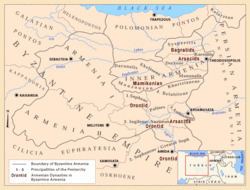Government Not specified Established 387 AD Founded 387 AD | Historical era Middle Ages Disestablished 536 | |
 | ||
Religion Armenian ApostolicChalcedonian Christianity Capitals Malatya, Sivas, Arsamosata, Erzurum | ||
Byzantine Armenia, sometimes Western Armenia, is the name given to the parts of Kingdom of Armenia that became part of the Byzantine Empire. The size of the territory varied over time, depending on the degree of control the Byzantines had over Armenia.
Contents
The Byzantine and Sassanid Empires divided Armenia in 387 and in 428. Western Armenia fell under Byzantine rule, and Eastern Armenia fell under Sassanid control. Even after the establishment of the Bagratid Armenian Kingdom, parts of historic Armenia and Armenian-inhabited areas were still under Byzantine rule.
The Armenians had no representation in the Ecumenical Council of Chalcedon in 451, due to their struggle against the Sassanids in an armed rebellion. For that reason, there appeared a theological drift between Armenian and Byzantine Christianity.
Regardless, many Armenians became successful in the Byzantine Empire. Numerous Byzantine emperors were either ethnically Armenian, half-Armenian, part-Armenian or possibly Armenian; although culturally Greek. The best example of this is Emperor Heraclius, whose father was Armenian and mother Cappadocian. Emperor Heraclius began the Heraclean Dynasty (610–717). Basil I is another example of an Armenian beginning a dynasty; the Macedonian dynasty. Other great emperors were Romanos I, John I Tzimiskes, and Nikephoros II.
Armenian military in the Byzantine Army
Armenia made great contributions to Byzantium through its troops of soldiers. The empire was in need of a good army as it was constantly being threatened. The army was relatively small, never exceeding 150,000 men. The military was sent to different parts of the empire, and took part in the most fierce battles and never exceeded 20,000 or 30,000. men. From the 5th century forwards the Armenians were regarded as the main constituent of the Byzantine army. Procopius recounts that the scholarii, the palace guards of the emperor, "were selected from amongst the bravest Armenians".
Armenian soldiers in the Byzantine army are cited during the following centuries, especially during the 9th and the 10th centuries, which might have been the period of greatest participation of the Armenians in the Byzantine army. Byzantine and Arab historians are unanimous in recognizing significance of the Armenians soldiers. Charles Diehl, for instance, writes: “The Armenian units, particularly during this period, were numerous and well trained.” Another Byzantine historian praises the decisive role which the Armenian infantry played in the victories of the Byzantine emperors Nicephorus Phocas and John Tzimiskes.
At that time the Armenians served side by side with the Norsemen who were in the Byzantine army. This first encounter between the Armenian mountain-dwellers and the Norse has been discussed by Nansen, who brings these two elements closer to each other and records: “It was the Armenians who together with our Scandinavian forefathers made up the assault units of Byzantine.” Moreover, Bussel underlines the similarities in the way of thinking and the spirit of the Armenian feudal lords and the northern warriors. He claims that, in both groups, there was a strange absence and ignorance of government and public interest and at the same time an equally large interest in achieving personal distinctions and a loyalty towards their masters and leaders.
Armenian Emperors of Byzantium
The partition of the Roman Empire between the two sons of the Emperor Theodosius was soon followed by a predominance of foreign elements in the court of Byzantium, the eastern half of the divided world. The proximity of this capital of the East to Armenia attracted to the shores of the Bosporus a great number of Armenians, and for three centuries they played a distinguished part in the history of the Eastern Empire.
The important role played in the history of Byzantium by the Armenians has been generally unrecognized.
